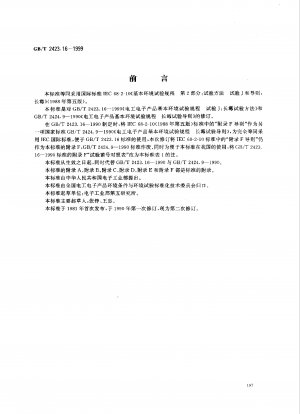GB/T 2423.16-1999
Environmental testing for electric and electronic products-- Part 2: Tests--Test J and guidance: Mould growth (English Version)
- Standard No.
- GB/T 2423.16-1999
- Language
- Chinese, Available in English version
- Release Date
- 1999
- Published By
- General Administration of Quality Supervision, Inspection and Quarantine of the People‘s Republic of China
- Status
- 2009-10
- Replace By
- GB/T 2423.16-2008
- Latest
- GB/T 2423.16-2022
- Scope
- In this test, the selected mold spores are inoculated on the assembled sample, and then cultivated for a period of time under conditions that promote spore germination and mold growth to carry out the mold growth test. Two different test methods are given in this test. Test Method 1 specifies direct inoculation of the sample with mold spores; Test Method 2 specifies the inoculation of the sample after pretreatment of the sample with a nutrient solution that supports the growth of the mold. This test procedure can be used to assess the extent of mold growth and/or possible performance degradation when assembled samples must be exposed to airborne mold spores and where climatic conditions favor mold growth. It is recommended that other established fungal test procedures be used to assess the susceptibility of used structural materials to damage due to mold contamination and that only materials not subject to severe mold attack be used. This test procedure is also applicable to assembled samples which do not have to be exposed to mold spores during work, but which may have to be temporarily exposed to mold spores during storage or transport. When assembled samples are exposed to the atmosphere during storage, use, or transport, or are unprotected during handling, surface contamination from dust, stains, condensed volatile nutrients, or grease may deposit on the sample. This surface contamination can lead to increased mold implantation and can cause more mold growth and damage. The effect of this contamination can be assessed using Test Method 2. If assembled samples are protected from exposure to mold spores, the ability of the samples to withstand the rigorous procedures of this test is unnecessary, even when working in areas where mold spores are abundant. Due to the difficulty of maintaining the necessary test conditions in a very large test chamber, large composite devices are usually tested with several subassemblies. Overall, this will minimize testing costs, since several subassemblies may be so structurally similar that only one of them needs to be tested
GB/T 2423.16-1999 history
- 2022 GB/T 2423.16-2022 Environmental testing—Part 2: Test methods—Test J and guidance: Mould growth
- 2008 GB/T 2423.16-2008 Environmental testing for electric and electronic products.Part 2:Test methods.Test J and guidance:Mould growth
- 1999 GB/T 2423.16-1999 Environmental testing for electric and electronic products-- Part 2: Tests--Test J and guidance: Mould growth

GB/T 2423.16-1999 -All Parts
GB/T 2423.1-2008 Environmental testing for electric and electronic products.Part 2:Test methods.Tests A:Cold
GB/T 2423.10-2019 Environmental testing—Part 2:Test methods—Test Fc:Vibration(sinusoidal)
GB/T 2423.101-2008 Environmental testing for electric and electronic products.Part 2:Test methods.Test: Inclinations and swings
GB/T 2423.102-2008 Environmental testing for electric and electronic products.Part 2:Test method.Test:combined temperature(cold and heat)/low air pressure/vibration(sinusoidal)
GB/T 2423.11-1997 Environmental testing for electric and electronic products. Part 2: Test methods. Test Fd: Random vibration wide band--General requirements
GB/T 2423.12-1997 Environmental testing for electric and electronic products. Part 2: Test methods. Test Fda: Random vibration wide band--Reproducibility high
GB/T 2423.13-1997 Environmental testing for electric and electronic products. Part 2: Test methods. Test Fdb: Random vibration wide band--Reproducibility medium
GB/T 2423.14-1997 Environmental testing for electric and electronic products. Part 2: Test methods. Test Fdc: Random vibration wide band--Reproducibility low
GB/T 2423.15-2008 Environmental testing for electric and electronic products.Part 2:Tests methods.Test Ga and guidance:Acceleration,steady
GB/T 2423.16-2022 Environmental testing—Part 2: Test methods—Test J and guidance: Mould growth
GB/T 2423.17-2008 Environmental testing for electric and electronic products.Part 2:Test method.Test Ka:Salt mist
GB/T 2423.18-2021 Environmental testing—Part 2: Test methods—Test Kb:Salt mist, cyclic(sodium chloride solution)
GB/T 2423.19-2013 Environmental testing.Part 2:Test methods.Test Kc:Sulphur dioxide test for contacts and connections
GB/T 2423.2-2008 Environmental testing for electric and electronic products.Part 2:Test methods.Tests B:Dry heat
GB/T 2423.20-2014 Environmental testing.Part 2: Test methods.Test Kd: Hydrogen sulphide test for contacts and connections
GB/T 2423.21-2008 Environmental testing for electric and electronic products.Part 2 Test methods Test M:Low air pressure
GB/T 2423.22-2012 Environmental testing.Part 2:Test methods.Test N:Change of temperature
GB/T 2423.23-2013 Environmental testing.Part 2:Test methods.Test Q:Sealing
GB/T 2423.24-2022 Environmental testing—Part 2: Test methods—Test S: Simulated solar radiation at ground level and guidance for solar radiation testing and weathering
GB/T 2423.25-2008 Environmental testing for electric and electronic products.Part2:Tsets Tset Z/AM:Combined cold/low air pressure tests
GB/T 2423.26-2008 Environmental testing for electric and electronic products.Part 2 Test methods TestZ/BM:Combined dry heat/low air pressure tests
GB/T 2423.27-2020 Environmental testing—Part 2: Test methods—Test method and guidance: Combined temperature or temperature and humidity with low air pressure tests
GB/T 2423.28-2005 Environmental testing for electric and electronic products.Part2:Test methods-Test T:Soldering
GB/T 2423.29-1999 Environmental testing for electric and electronic products-- Part 2:Test methods Test U:robustness of terminations and integral mounting devices
GB/T 2423.3-2016 Environmental testing—Part 2:Testing method—Test Cab:Damp heat,steady state
GB/T 2423.30-2013 Environmental testing.Part 2:Test methods.Test XA and guidance:Immersion in cleaning solvents